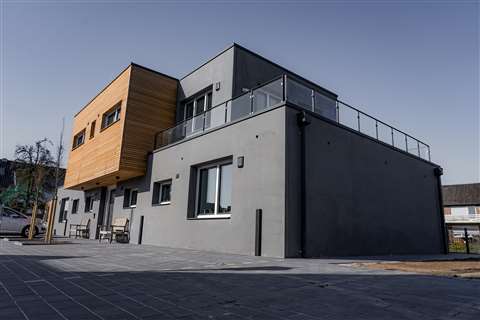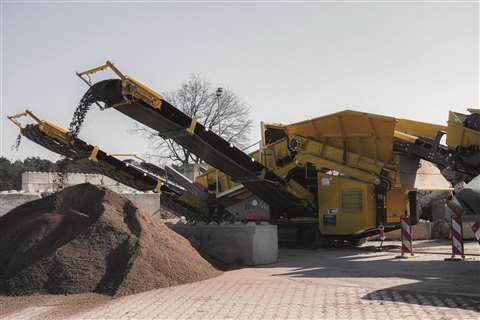The house built with recycled construction and demolition waste
19 April 2023
German company Büscher has built a complete house out of 75% recycled construction and demolition waste, with load-bearing and non-load-bearing interior wall elements made of 100% recycled aggregates – with the help of crushing and screening equipment from Belgium-based manufacturer Keestrack.
 The three-family house built with prefab elements of recycled natural mineral substitutes. (Photo: Keestrack)
The three-family house built with prefab elements of recycled natural mineral substitutes. (Photo: Keestrack)
Described as the first company to achieve this, Büscher – which started out making concrete more than 60 years ago – gained approval from the Deutsches Institut für Bautechnik (DIBt, or German Federal Association for Building Materials) for its innovative approach.
It took eight years of research and development to prove the house could be sustainably built, even at lower costs, but only four months to construct the three-family home with paint-ready prefab elements.
And while the use of recycled materials does not extend to the outside walls, Büscher has already thought ahead to the house’s eventual demolition, when the inside walls will be recycled into new concrete and re-enter the circular economy.
Büscher’s factory in Münsterland, North-Rhine Westphalia is powered solar panels delivering up to 323 kW/h of renewable electricity. The Keestrack R3e zero impact crusher and the K4e zero screen used by the company are also powered by renewable energy and do not have a combustion engine.
 Keestrack’s K4e Zero and R3e Zero at the Büscher site in Germany. (Photo: Keestrack)
Keestrack’s K4e Zero and R3e Zero at the Büscher site in Germany. (Photo: Keestrack)
The R3e Zero is equipped with a vibrating feeder with a pre-screen of 1,200 x 920 mm (47 x 36 in) to optimise crushing results and to minimize wear, an inlet opening of 770 x 960 mm (30 x 37 in) and a rotor diameter of 1,100 mm (43 in) and a rotor width of 920 mm. The crusher equipped in closed circuit with recirculation conveyor and a precession screen of 3,100 x 1,400 mm (122 x 55 in) produces a defined aggregate product size.
The K4e Zero has a capacity up to 350 t/hr, with a double deck screen box of 4,200 x 1,500 mm (165 x 59 in), standard heavy duty plate apron feeder and hydraulic adjustable screen angle gives.
At its recycling site, Büscher chose to have the fine and middle fraction conveyor at the same side of the screen to improve the accessibility for the wheeled loader, and both Keestrack machines at Büscher are equipped with remote controls to operate the crusher and screen from the excavator.
STAY CONNECTED


Receive the information you need when you need it through our world-leading magazines, newsletters and daily briefings.
CONNECT WITH THE TEAM










